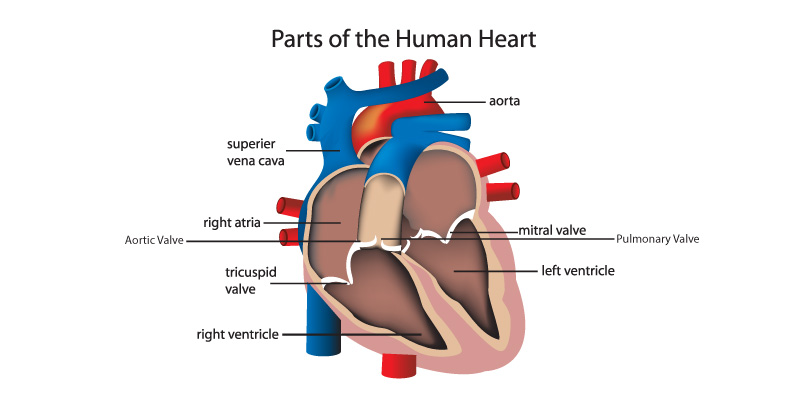Heart Valve Disease is a condition, in which one or more valves of the heart are unable to function properly. Normally, the valves of the heart have flaps that open and close with each heartbeat. This allows the blood to flow through the upper heart chamber (atria) to the lower heart chamber (ventricles) and to the rest of the body.
However, in some cases, one or more valves of the heart don’t open or close properly causing a disruption in the flow of blood through the body. This condition is termed as Heart Valve Disease or Heart Valve Disorder.
How Do Heart Valves Work?
There are four valves (tricuspid valve, pulmonary valve, mitral valve, aortic valve) in the heart, which make sure that the blood flows in the correct direction.

The blood flows from the right and left atria to the ventricles with the help of the open mitral and tricuspid valves. When the ventricles are full, these valves close and prevent the backward flow of blood into the atrium. After the ventricles are filled with blood, they begin to contract and open the aortic and pulmonic valves so that the pumped blood is out of the ventricles and flow in the rest of the body. When the ventricles stop contracting, these valves also get close to prevent the backward flow of blood in the ventricles.
The process continues in each heartbeat assuring the sufficient supply of blood to the heart, lungs, and the body.
In Heart Valve Disease, the valves don’t work properly and blood is not flowing in the right direction.
Types of Heart Valves Disease
- Mitral Valve Prolapse: It is also known as Click-murmur Syndrome, Barlow’s Syndrome, Floppy Valve Syndrome, and Balloon Mitral Valve. This condition occurs when mitral valves are unable to function well, leading to backward blood flow to the atria. Though people with Mitral Valve Prolapse don’t have any visible symptoms, there can be some possible symptoms such as chest pain, heart palpitations, fatigue, shortness of breath, cough, etc.
- Bicuspid Aortic Valve Disease: It is a condition where a person is born with an aortic valve that has two flaps instead of three. The problem is genetic and in some cases, there are visible symptoms since the birth of a person. These symptoms are chest pain, shortness of breath, fainting, dizziness, etc.
- Valvular Stenosis: This type of condition occurs when the heart’s valves are not able to open completely, which cause less supply of blood. This can occur to any of the heart’s valves due to stiffening and thickening. The symptoms of this condition are Chest pain, dizziness, shortness of breath, fatigue, fainting, etc.
- Valvular Regurgitation: It is also called a leaky valve that occurs when any valve of the heart doesn’t close properly. This also causes the backward blood flow. The symptoms of this problem are heart palpitations, lightheadedness, fatigue, shortness of breath, swollen feet and ankles, etc.
Some Facts About Heart Valve Disease
- Heart Valve disease is a condition of heart valves leading to the change of blood flow.
- According to the American College of Cardiology reports, approximately 5 million Americans are diagnosed with Heart Valve Disease every year.
- According to the Centers for Disease Control and Prevention estimation, about 2.5% of the population of the U.S. have Heart Valve Disease and is more common in older adults.
- The same report states that about 1% to 2% of the population has a Bicuspid aortic valve and is more common among men.
- Most Heart Valve Disease deaths happen due to aortic valve disease, according to the 2017 CDC estimation.
Causes of Heart Valve Disease
There are a number of reasons that can cause Heart Valve Disease. Some of them are:
- Congenital valve disease, or birth defect
- Rheumatic fever, an inflammatory condition caused due to infection with group A Streptococcus bacteria
- Infective endocarditis (inflammation of heart tissue)
- Age-related changes like calcium deposits
- Coronary artery disease caused due to hardening or narrowing arteries
- Heart attack
- Cardiomyopathy, where the heart muscle becomes weak
- Syphilis, a rare sexually transmitted infection
- High blood pressure, or Hypertension
- Aortic aneurysm, an abnormal bulging of the aorta i.e. largest artery of the body
- Atherosclerosis, where the arteries become hard
- Myxomatous degeneration, where the connective tissues in the mitral valve become weak
- lupus, an autoimmune disease
Other risk factors include:
- Older age
- History of heart infections
- History of heart attack or heart disease
- High cholesterol
- Diabetes
Symptoms of Heart Valve Disease

The symptoms of Heart Valve Disease vary from person to person depending upon the severity of the condition. Some people don’t experience any symptoms, but in some case, there are symptoms which include:
- Difficulty in breathing or breath shortness
- Weakness
- Dizziness
- Fatigue
- Chest discomfort or Chest pain
- Heart Palpitation
- Fainting
- Frequent weight gain
- Pulmonary edema, fluid accumulation in lungs
- Water retention, swelling on feet, ankles, legs
- Abdominal swelling
- Irregular heartbeat
Diagnosis of Heart Valve Disease

To diagnose heart valve disorder, the doctor first checks the heartbeats with a stethoscope. This will help to monitor any heart rate abnormalities. The doctor also checks for any fluid buildup in the lungs and body for symptoms of water retention. He may perform some tests to diagnose Heart Valve Disease that include:
- Electrocardiogram: This test shows the heart’s electrical activity and helps in determining abnormal heart rhythms.
- Echocardiogram: This test helps in creating images of the heart chambers and valves by using sound waves.
- Chest X-ray: This test will help to know whether the heart is enlarged.
- MRI Scan: This test is also performed to take detailed images of the heart.
- Cardiac Catheterization: Doctors may also use a catheter with a camera to see the heart and diagnose valve disorders.
- Stress Tests: This test is performed to know how symptoms are affected when a person is working or exercising.
Conclusion
Heart Valve Disease is a serious condition that disturbs the flow of blood through the heart and body. Though the disease doesn’t show any warning signs in most cases, there are a few symptoms that may indicate Heart Valve Disease. So it is advisable for a person to consult doctors or professionals as soon as he/she notices any symptoms.




